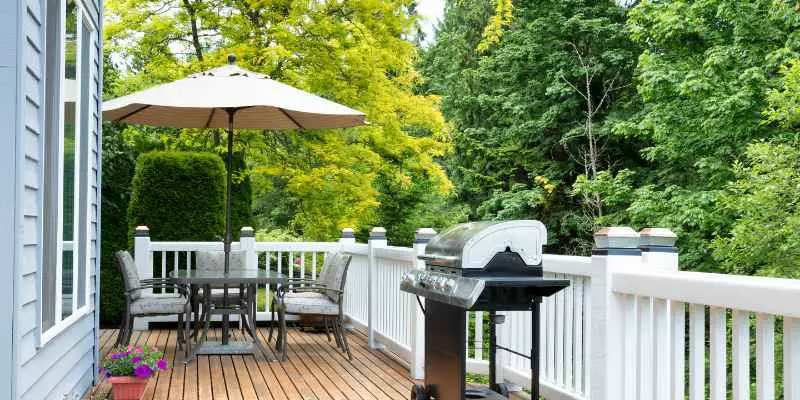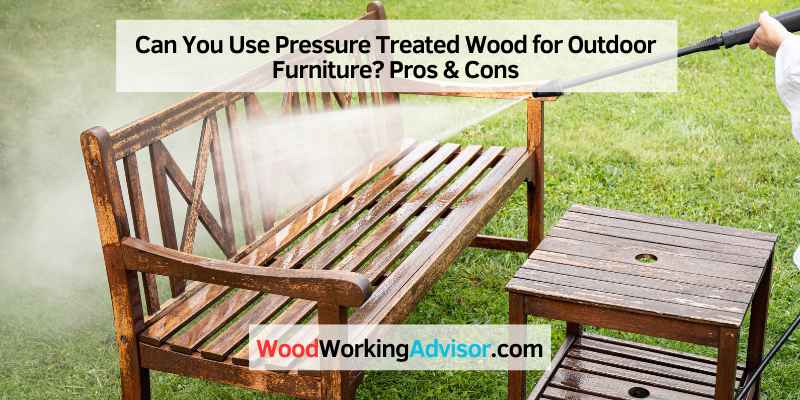Yes, pressure treated wood is suitable for outdoor furniture due to its durability and resistance to rot and decay. It is commonly used for outdoor projects like furniture, decks, and fences.
Pressure treated wood is chemically treated to withstand outdoor elements and is a popular choice for long-lasting outdoor furniture. Its ability to resist moisture, insects, and rot makes it a practical option for outdoor use. Additionally, pressure treated wood can be easily stained or painted to match your outdoor decor, providing both functionality and aesthetics.
Its affordability and low maintenance requirements make it a practical choice for outdoor furniture that will withstand the test of time.
Introduction To Pressure Treated Wood
Pressure treated wood is ideal for outdoor furniture due to its durability against weather elements. It is resistant to rot and insect damage, making it a reliable choice for long-lasting outdoor pieces. The treatment process involves chemicals that provide protection, ensuring your furniture stands the test of time.
What Is Pressure Treated Wood?
Pressure treated wood is a type of wood that has been treated with chemicals to increase its resistance to rot, decay, and insects. The process of pressure treating involves placing the wood in a vacuum-sealed tank and then forcing chemicals into the wood under high pressure. The most common chemicals used in pressure treated wood are chromated copper arsenate (CCA), alkaline copper quat (ACQ), and copper azole (CA).
Common Uses
Pressure treated wood is commonly used in outdoor construction projects, such as decks, fences, and retaining walls. It is also used for landscaping timbers, walkways, and other outdoor structures. The increased resistance to rot and decay makes pressure treated wood a popular choice for outdoor furniture as well. However, not all pressure treated wood is created equal, and some types are better suited for certain applications than others. It is important to choose the right type of pressure treated wood for your specific project to ensure the best results.
When it comes to using pressure treated wood for outdoor furniture, there are a few things to keep in mind. While pressure treated wood is resistant to rot and decay, it is not immune to the effects of weather and sun exposure. Over time, pressure treated wood can warp, crack, and fade if not properly maintained. To ensure the longevity of your outdoor furniture, it is important to protect it from the elements and to use a high-quality sealant or stain to help preserve the wood.
Safety Concerns With Pressure Treated Wood
When using pressure treated wood for outdoor furniture, it’s important to be aware of the safety concerns associated with this type of wood. While pressure treated wood is resistant to rot and insect damage, it contains chemicals that can pose potential risks to human health and the environment.
Chemical Treatments
Pressure treated wood is infused with chemicals such as chromated copper arsenate (CCA), alkaline copper quaternary (ACQ), or copper azole (CA) to enhance its durability and resistance to decay. These chemicals can leach out of the wood over time, especially when exposed to moisture, and may pose health risks if proper precautions are not taken.
Handling And Working Safely
When working with pressure treated wood, it’s crucial to take safety measures to minimize exposure to the chemicals. This includes wearing protective gloves, goggles, and a dust mask when cutting or sanding the wood. Additionally, it’s essential to work in a well-ventilated area and to clean up any sawdust or debris after working with the wood.
Advantages Of Using Pressure Treated Wood For Outdoor Furniture

When it comes to outdoor furniture, durability is key. You want something that can withstand the harsh elements and still look great for years to come. That’s where pressure treated wood comes in. With its unique properties, pressure treated wood offers a range of advantages for outdoor furniture.
Durability Against Elements
One of the biggest advantages of using pressure treated wood for outdoor furniture is its exceptional durability against the elements. This type of wood is treated with chemicals that make it resistant to rot, decay, and insect damage. As a result, your outdoor furniture can brave the harshest weather conditions without losing its structural integrity.
Cost-effectiveness
Another advantage of pressure treated wood for outdoor furniture is its cost-effectiveness. Compared to other types of wood, pressure treated wood is generally more affordable. This makes it a great option for those on a budget or looking to furnish a large outdoor space without breaking the bank. You can enjoy the benefits of durable and long-lasting furniture without spending a fortune.
Maintenance Requirements
Maintenance is always a consideration when it comes to outdoor furniture. Fortunately, pressure treated wood requires minimal maintenance. Its chemical treatment helps to prevent rot and decay, reducing the need for frequent staining or sealing. A simple cleaning with mild soap and water is usually sufficient to keep your pressure treated wood furniture looking its best.
Overall, pressure treated wood offers several advantages for outdoor furniture. Its durability against the elements, cost-effectiveness, and low maintenance requirements make it a practical and long-lasting choice. Whether you’re furnishing a patio, deck, or garden, pressure treated wood can provide the durability and aesthetic appeal you desire.
Drawbacks To Consider
While pressure treated wood can be a practical choice for outdoor furniture, there are several drawbacks to consider. These include the potential for chemical leaching, aesthetic limitations, and workability challenges.
Chemical Leaching
Chemical leaching is a concern with pressure treated wood, as the chemicals used to treat the wood can leach out over time, posing potential health risks. This can be particularly worrisome in outdoor furniture, where prolonged exposure to rain and sunlight can expedite the leaching process.
Aesthetic Limitations
Pressure treated wood may not offer the same aesthetic appeal as untreated or naturally finished wood. Aesthetic limitations such as a greenish tint and uneven absorption of stains or paints can detract from the overall visual appeal of outdoor furniture made from pressure treated wood.
Workability Challenges
Workability challenges are another consideration, as pressure treated wood can be more difficult to cut, drill, and manipulate than untreated wood. This can make the construction and customization of outdoor furniture a more labor-intensive and time-consuming process.
Environmental Considerations
When considering the use of pressure treated wood for outdoor furniture, it is crucial to take into account the environmental impact. The production and disposal of pressure treated wood can have significant implications for the environment. Understanding the sustainability issues and disposal concerns is essential for making informed decisions.
Sustainability Issues
Pressure treated wood is often treated with chemicals such as chromated copper arsenate (CCA) or alkaline copper quaternary (ACQ), which can have adverse effects on the environment. These chemicals can leach into the soil and water, posing a threat to plants and aquatic life. Sustainable alternatives, such as naturally resistant woods or eco-friendly treatment methods, should be considered to minimize environmental impact.
Disposal Concerns
Disposing of pressure treated wood can be problematic due to its chemical treatment. Burning pressure treated wood releases harmful toxins into the air, while landfill disposal can lead to leaching of chemicals into the soil. Proper disposal methods, such as recycling or seeking out facilities equipped to handle treated wood, are crucial to prevent environmental contamination.
Alternative Materials For Outdoor Furniture
When it comes to outdoor furniture, alternative materials offer a range of options to consider. From durability to aesthetic appeal, different materials can suit various preferences and needs. Let’s explore some alternatives for creating stylish and functional outdoor furniture.
Natural Woods
Natural woods like teak, cedar, and eucalyptus are popular choices for outdoor furniture due to their durability and natural beauty.
Composite Materials
Composite materials, such as polywood and resin, provide the look of wood with added weather resistance and low maintenance.
Metal Options
Metal options like aluminum and stainless steel offer modern designs and excellent resistance to corrosion for outdoor furniture.
Making An Informed Decision
When considering using pressure treated wood for outdoor furniture, it’s crucial to make an informed decision. Understanding the potential risks and benefits, such as the wood’s resistance to rot and decay versus the chemicals it contains, can help you weigh your options effectively.
Always prioritize safety and longevity when choosing materials for outdoor projects.
Balancing Pros And Cons
Consider the durability and resistance of pressure-treated wood.
Weight the potential risks of chemical exposure against longevity.
Balance affordability with maintenance requirements.
Personal Preferences And Priorities
Evaluate your design aesthetic and desired style.
Take into account environmental concerns and sustainability.
Consider budget constraints and time investment for upkeep.
Final Thoughts
Summarizing Key Points
Pressure treated wood is suitable for outdoor furniture due to its durability and resistance to rot and insects.
Proper sealing and maintenance can extend the lifespan of pressure treated wood furniture.
Future Outlook
Advancements in pressure treatment technology may lead to even more durable outdoor furniture options in the future.
Exploring alternative materials may provide sustainable and eco-friendly options for outdoor furniture construction.

Frequently Asked Questions
Can Pressure Treated Wood Be Used For Outdoor Furniture?
Yes, pressure treated wood can be used for outdoor furniture. However, it is important to note that the chemicals used in the pressure treating process can be harmful to humans and pets. It is recommended to use a sealant or paint to cover the wood to prevent direct contact.
How Long Does Pressure Treated Wood Last?
Pressure treated wood can last for up to 40 years when properly maintained. The life expectancy of the wood varies depending on the type of wood and the level of treatment it has undergone. Applying a sealant or paint can help extend the life of the wood.
Is Pressure Treated Wood Safe For Humans And Pets?
While pressure treated wood is safe to use for outdoor furniture, the chemicals used in the treatment process can be harmful to humans and pets if ingested. It is important to take precautions such as using gloves and a mask when cutting or sanding the wood, and avoiding direct contact with skin.
What Are The Benefits Of Using Pressure Treated Wood For Outdoor Furniture?
One of the main benefits of using pressure treated wood for outdoor furniture is its durability. The wood is resistant to rot, decay, and insect damage, making it ideal for outdoor use. It also requires minimal maintenance and is cost-effective compared to other types of wood.
Conclusion
Pressure treated wood can be a suitable option for outdoor furniture due to its durability and resistance to rot and decay. However, it is important to take precautions such as using stainless steel or coated screws to prevent corrosion. Regular maintenance and sealing can also help prolong the lifespan of the furniture.
Ultimately, the choice of wood for outdoor furniture should be based on personal preference, budget, and the specific requirements of the project.


